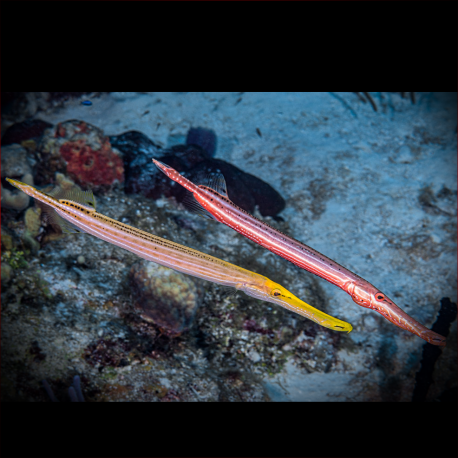More info
Datasheet
| Minimum Tank Size | 1800 litres / 475.51 US gallons |
| Maximum Size | 100.0cm / 39.37inches |
| Reef Compatible | Reef safe with caution |
| Temperament | Mostly peaceful but might be aggressive towards similar species |
| Temperature | 22.2°C / 71.96°F - 25.6°C / 78.08°F |
| Specific Gravity | 1.020-1.025 |
| Carbonate Hardness | 8-12 |
| pH | 8.1-8.4 |
General Description
The Trumpetfish, belonging to the Aulostomidae family, are captivating aquarium inhabitants known for their large size, with a maximum length reaching 100.0cm. Found in the West Indian Ocean, The Mexican Gulf, and the West Atlantic, they require a significant amount of space due to their active swimming nature.
Aquarium Suitability
Considered suitable for special aquarium setups, Trumpetfish demand a large swimming area of over 1000 liters without obstructions, alongside hiding spots. Their predatory nature makes them a threat to smaller fish and crustaceans, so careful consideration must be taken when selecting tankmates.
Demands, Care and Hardiness
With an average hardiness level, Trumpetfish can be initially shy and are prone to jumping out of open aquariums. They thrive best when provided live food for adaptation and require a large tank size of at least 1800 liters. These fish have a fun and interesting personality, becoming attached to their caretakers over time.
Reef Suitability
Reef safe with caution, Trumpetfish can coexist in a reef aquarium if mindful of their predatory behavior towards smaller inhabitants like shrimp and crabs. They tend to do better without other members of the same species in the tank.
Aquarium Setup
To accommodate Trumpetfish, a spacious tank with ample swimming space and hiding spots between live rocks is essential. Maintaining a stable water condition with a pH range of 8.1-8.4, a temperature between 22.2-25.6°C, and a salinity level of 1.020-1.025 is crucial for their well-being.
Behaviour
Characterized as mostly peaceful, Trumpetfish may display aggression towards similar species as they grow. It is advisable to introduce them to more aggressive tankmates only after they have acclimatized to their new environment.
Feeding and Diet
These fish primarily feed on live prey such as small fish and crustaceans, transitioning to frozen fish portions and crustaceans over time. Their diet may include fish, larger crustaceans like shrimp and crabs, as well as small crustaceans such as krill, mysis, and artemia.
Habitat and Distribution
In their natural habitat, Trumpetfish are found in the West Indian Ocean, The Mexican Gulf, and the West Atlantic. They prefer open waters with ample swimming space to move around freely and hunt for prey.

